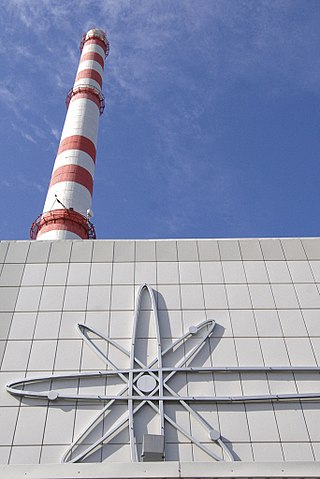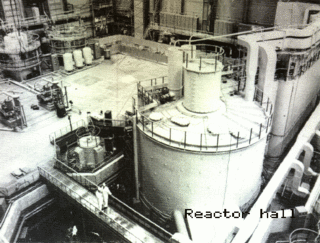
A nuclear power plant (NPP) is a thermal power station in which the heat source is a nuclear reactor. As is typical of thermal power stations, heat is used to generate steam that drives a steam turbine connected to a generator that produces electricity. As of September 2023, the International Atomic Energy Agency reported there were 410 nuclear power reactors in operation in 32 countries around the world, and 57 nuclear power reactors under construction.

Rosatom, also known as Rosatom State Nuclear Energy Corporation, the State Atomic Energy Corporation Rosatom, or Rosatom State Corporation, is a Russian state corporation headquartered in Moscow that specializes in nuclear energy, nuclear non-energy goods and high-tech products. It was established in 2007 and comprises more than 350 enterprises, including scientific research organizations, a nuclear weapons complex, and the world's only nuclear icebreaker fleet.
The Megatons to Megawatts Program, also called the United States-Russia Highly Enriched Uranium Purchase Agreement, was an agreement between Russia and the United States whereby Russia converted 500 metric tons of "excess" weapons-grade uranium into 15,000 metric tons of low enriched uranium, which was purchased by the US for use in its commercial nuclear power plants. The official name of the program is the "Agreement between the Government of the Russian Federation and the Government of the United States of America Concerning the Disposition of Highly-Enriched Uranium Extracted from Nuclear Weapons", dated February 18, 1993. Under this Agreement, Russia agreed to supply the United States with low-enriched uranium (LEU) obtained from high-enriched uranium (HEU) found to be in excess of Russian defense purposes. The United States agreed to purchase the low-enriched uranium fuel.

The water-water energetic reactor (WWER), or VVER is a series of pressurized water reactor designs originally developed in the Soviet Union, and now Russia, by OKB Gidropress. The idea of such a reactor was proposed at the Kurchatov Institute by Savely Moiseevich Feinberg. VVER were originally developed before the 1970s, and have been continually updated. As a result, the name VVER is associated with a wide variety of reactor designs spanning from generation I reactors to modern generation III+ reactor designs. Power output ranges from 70 to 1300 MWe, with designs of up to 1700 MWe in development. The first prototype VVER-210 was built at the Novovoronezh Nuclear Power Plant.

Russia is one of the world's largest producers of nuclear energy. In 2020 total electricity generated in nuclear power plants in Russia was 215.746 TWh, 20.28% of all power generation. The installed gross capacity of Russian nuclear reactors is 29.4 GW in December 2020.
As of 2023, Finland has five operating nuclear reactors in two power plants, all located on the shores of the Baltic Sea. Nuclear power provided about 34% of the country's electricity generation in 2020. The first research nuclear reactor in Finland was commissioned in 1962 and the first commercial reactor started operation in 1977. The fifth reactor started operation in April 2023.

The Beloyarsk Nuclear Power Station was the third of the Soviet Union's nuclear plants. It is situated by Zarechny in Sverdlovsk Oblast, Russia. Zarechny township was created to service the station, which is named after the Beloyarsky District. The closest city is Yekaterinburg.

The BN-350 was a sodium-cooled, fast reactor located at the Mangyshlak Nuclear Power Plant, located in Aktau, Kazakhstan, on the shore of the Caspian Sea.
The program for nuclear power in Indonesia includes plans to build nuclear reactors in the country for peaceful purposes. Indonesia prohibited development of nuclear weapon or any offensive uses due to signing the Treaty on the Non-Proliferation of Nuclear Weapons on 2 March 1970 and ratified it as Law No. 8/1978 on 18 December 1978.

Kudankulam Nuclear Power Plant is the largest nuclear power station in India, situated in Kudankulam in the Tirunelveli district of the southern Indian state of Tamil Nadu. Construction on the plant began on 31 March 2002, but faced several delays due to opposition from local fishermen. KKNPP is scheduled to have six VVER-1000 reactors built in collaboration with Atomstroyexport, the Russian state company and Nuclear Power Corporation of India Limited (NPCIL), with an installed capacity of 6,000 MW of electricity.

Floating nuclear power stations are vessels designed by Rosatom, the Russian state-owned nuclear energy corporation. They are self-contained, low-capacity, floating nuclear power plants. Rosatom plans to mass-produce the stations at shipbuilding facilities and then tow them to ports near locations that require electricity.
Nuclear power is the fifth-largest source of electricity in India after coal, gas, hydroelectricity and wind power. As of November 2020, India has 23 nuclear reactors in operation in 8 nuclear power plants, with a total installed capacity of 7,380 MW. Nuclear power produced a total of 43 TWh in 2020–21, contributing 3.11% of total power generation in India. 10 more reactors are under construction with a combined generation capacity of 8,000 MW.
Energy in Kazakhstan describes energy and electricity production, consumption and import in Kazakhstan and the politics of Kazakhstan related to energy.

Akademik Lomonosov is a non-self-propelled power barge that operates as the first Russian floating nuclear power station. The ship was named after academician Mikhail Lomonosov. It is docked in the Pevek harbour, providing heat to the town and supplying electricity to the regional Chaun-Bilibino power system. It is the world’s northernmost nuclear power plant.
National nuclear energy policy is a national policy concerning some or all aspects of nuclear energy, such as mining for nuclear fuel, extraction and processing of nuclear fuel from the ore, generating electricity by nuclear power, enriching and storing spent nuclear fuel and nuclear fuel reprocessing. Nuclear energy policies often include the regulation of energy use and standards relating to the nuclear fuel cycle.
The BN-800 reactor is a sodium-cooled fast breeder reactor, built at the Beloyarsk Nuclear Power Station, in Zarechny, Sverdlovsk Oblast, Russia. The reactor is designed to generate 880 MW of electrical power. The plant was considered part of the weapons-grade Plutonium Management and Disposition Agreement signed between the United States and Russia. The reactor is part of the final step for a plutonium-burner core The plant reached its full power production in August 2016. According to Russian business journal Kommersant, the BN-800 project cost 140.6 billion rubles.

The BN-1200 reactor is a sodium-cooled fast breeder reactor project, under development by OKBM Afrikantov in Zarechny, Russia. The BN-1200 is based on the earlier BN-600 and especially BN-800, with which it shares a number of features. The reactor's name comes from its electrical output, nominally 1220 MWe.
This is a history of nuclear power as realized through the first artificial fission of atoms that would lead to the Manhattan Project and, eventually, to using nuclear fission to generate electricity.

The Rooppur Nuclear Power Plant (Bengali: রূপপুর পারমাণবিক বিদ্যুৎকেন্দ্র) is a 2.4 GWe nuclear power plant project in Bangladesh. The nuclear power plant is being constructed at Rooppur of Ishwardi upazila in Pabna District, on the bank of the river Padma, 87 miles (140 km) west of Dhaka. It will be the country's first nuclear power plant, and the first of the two units is expected to go into operation in 2024. The VVER-1200/523 Nuclear reactor and critical infrastructures are being built by the Russian Rosatom State Atomic Energy Corporation. In the main construction period, the total number of employees will reach 12,500, including 2,500 specialists from Russia. It is expected to generate around 15% of the country's electricity when completed.

Aktau or Aqtau, Russian: Актау) is a city in Kazakhstan, located on the eastern shore of the Caspian Sea. Its current name means 'white mountain' in Kazakh, which may be due to its cliffs that overlook the Caspian. From 1964 to 1991, the city was known as Shevchenko. Its former name was given due to the eponymous Ukrainian poet's period of exile in the area. It is located on the Mangyshlak Peninsula and is the capital of the Mangystau Region.











